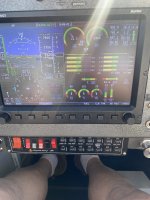Smilin' Jack
Well Known Member
We replaced the crankshaft in our superior IO-360. One of the 241 that the AD was issued for.
Reason for this we fly Angel Flights and did bot want to be sued if something would happen during a flight.
Question. What is your idle Oil Pressure after landing with a warm engine.
I have Dynon SkyView and oil pressure will sometimes go to 35 at approx 600 RPM. Will come right back up to 55 at 750 RPM.
In flight with oil temp 185. oP is 69.
All other indications are great
Appreciate any answers.

Reason for this we fly Angel Flights and did bot want to be sued if something would happen during a flight.
Question. What is your idle Oil Pressure after landing with a warm engine.
I have Dynon SkyView and oil pressure will sometimes go to 35 at approx 600 RPM. Will come right back up to 55 at 750 RPM.
In flight with oil temp 185. oP is 69.
All other indications are great
Appreciate any answers.


